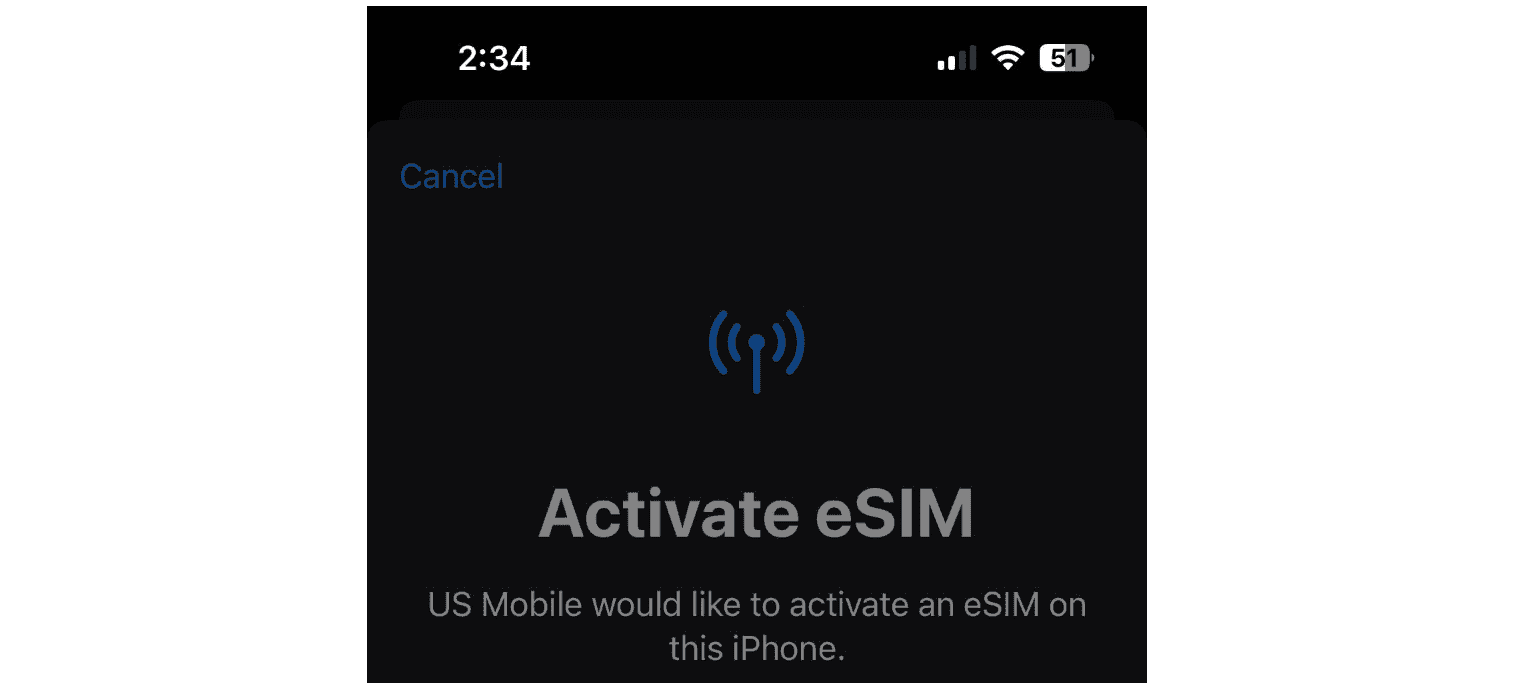eSIM technology is transforming mobile connectivity. This digital SIM card, embedded directly into devices, eliminates the need for physical SIM cards. eSIMs allow users to switch between mobile networks without changing physical cards, offering unprecedented flexibility and convenience.
Many consumers have questions about eSIM functionality and adoption. eSIMs work like traditional SIM cards but are activated remotely. This enables a fully digital customer experience for mobile network operators.
Compatibility is a common concern with eSIM technology. While not all devices support eSIMs yet, major smartphone manufacturers are increasingly incorporating this feature. As adoption grows, eSIMs are poised to become the new standard for mobile connectivity.
Understanding eSIM Technology
What is an eSIM?
An eSIM, or embedded SIM, is a digital SIM card. It’s a small chip built into your phone or device. You can use it to activate a cellular plan from your carrier without needing a physical SIM card.
How Does an eSIM Work?
An eSIM stores your subscription information. This information is what connects you to your carrier’s network. You can download this information from your carrier remotely.
What are the Benefits of Using an eSIM?
eSIMs offer several advantages:
- Convenience: You don’t need to visit a store or wait for a physical SIM card to arrive in the mail.
- Flexibility: You can easily switch between carriers or plans. This is helpful when you’re traveling internationally.
- Space-saving: eSIMs free up the physical SIM card slot. Manufacturers can use this space for other components or features.
- Dual SIM capabilities: Many devices allow you to use an eSIM and a physical SIM card simultaneously. This lets you have two phone numbers or plans on one device.
What are the Drawbacks of Using an eSIM?
eSIMs also have some limitations:
- Compatibility: Not all devices and carriers support eSIM technology.
- Switching devices: Transferring your eSIM profile to a new device can sometimes be more complex than swapping a physical SIM card.
- Troubleshooting: If you have issues with your eSIM, troubleshooting might require contacting your carrier.
How to Activate an eSIM
The activation process varies depending on your carrier and device. Generally, you’ll need to scan a QR code provided by your carrier or enter your plan details manually.
Which Devices and Carriers Support eSIMs?
Many popular smartphones, smartwatches, and tablets support eSIMs. Check your device’s specifications or your carrier’s website for compatibility information.
eSIMs and International Travel
eSIMs can be very convenient for international travel. They make it easy to switch to a local carrier’s plan when you arrive in a new country. This can often be more cost-effective than using your regular plan with roaming charges.
The Future of eSIMs
eSIM technology is becoming increasingly common. As more devices and carriers adopt eSIMs, they are likely to become the standard for connecting to cellular networks.
Comparison of eSIM and Physical SIM
| Feature | eSIM | Physical SIM |
|---|---|---|
| Form Factor | Digital, embedded chip | Physical card |
| Activation | Download profile | Insert into device |
| Switching Plans | Easier | Requires swapping cards |
| Device Compatibility | Limited but growing | Widely compatible |
| International Travel | More convenient | May require purchasing local SIMs |
iPhones and eSIM Technology: A Deep Dive
Apple has been a major proponent of eSIM technology, with many iPhone models supporting eSIM functionality. This allows iPhone users to take advantage of the convenience and flexibility that eSIMs offer.
Which iPhone Models Support eSIM?
Most iPhone models released since the iPhone XR and XS support eSIMs. This includes the newer iPhone 13 and 14 series, as well as the iPhone SE (2nd and 3rd generation).
How to Use eSIM on an iPhone
You can use an eSIM on your iPhone to activate a new cellular plan or convert your existing physical SIM to an eSIM. You can also use the Dual SIM feature to have two active lines on your iPhone. This can be useful for separating work and personal numbers or for using a local data plan while traveling.
Setting Up Dual SIM with an eSIM on iPhone
To use Dual SIM, you’ll need an iPhone with eSIM support and a cellular plan from a carrier that supports eSIM functionality. You can then add your cellular plan to your iPhone by scanning a QR code provided by your carrier or by manually entering your plan information.
Managing Your Cellular Plans on iPhone
Once you have multiple cellular plans on your iPhone, you can manage them in the Settings app. You can choose which line to use for calls, messages, and mobile data. You can also label your lines to easily identify them.
Benefits of Using eSIM on iPhone
Using an eSIM on your iPhone offers several benefits, including the ability to easily switch carriers, use a local data plan while traveling, and free up the physical SIM card slot for other uses.
Key Takeaways
- eSIMs are digital SIM cards embedded in devices, offering flexible network switching
- Remote activation enables a fully digital customer experience for mobile operators
- Device compatibility for eSIM technology is expanding as adoption increases
Adoption and Compatibility
eSIM technology adoption is accelerating globally. Mobile operators are embracing this new standard, while device manufacturers are integrating eSIM support into their products.
Global Standards and GSMA
The GSMA leads eSIM standardization efforts. They’ve developed specifications for consumer and M2M eSIMs. These standards ensure interoperability between different devices and networks worldwide.
GSMA’s Consumer eSIM specification enables remote SIM provisioning. This allows users to download operator profiles without physical SIM cards.
Mobile operators must comply with these standards to offer eSIM services. Many carriers now support eSIM activation and management through their platforms.
eSIM Activation Process
eSIM activation is typically faster and more convenient than traditional SIM setup. Users can activate their eSIM profiles in minutes, often without visiting a store.
The process usually involves:
- Scanning a QR code
- Downloading the operator’s app
- Following on-screen instructions
Some carriers offer eSIM activation through their websites or customer service channels. This flexibility benefits travelers and those switching providers.
Compatibility with Devices and Networks
eSIM compatibility is expanding rapidly across device types and mobile networks. Many flagship smartphones now support eSIM technology.
eSIM-compatible devices include:
- Google Pixel series (3 and newer)
- iPhone XS and later models
- Samsung Galaxy S20 and newer
- Select smartwatches and tablets
Most major mobile operators worldwide now support eSIM. However, availability may vary by region and plan type.
Users should check their carrier’s eSIM support before switching. Some older devices may require software updates to enable eSIM functionality.
eSIM adoption is particularly strong in IoT and enterprise sectors. It simplifies device management and enables remote provisioning at scale.
Advantages of eSIM Technology
eSIM technology offers significant benefits for travelers, reduces roaming fees, and enhances customer experience. This digital SIM solution provides flexibility and convenience for mobile users.
Benefits for Travelers
eSIM technology simplifies international travel. Users can switch carriers without changing physical SIM cards. This feature is especially useful in countries with limited network coverage.
eSIM-enabled devices allow travelers to buy local data plans instantly. No need to visit physical stores or wait for SIM card delivery. Travelers can activate new plans before arriving at their destination.
Many eSIM providers offer global data packages. These plans work in multiple countries, eliminating the need to purchase separate SIMs for each location.
Reducing Roaming Fees
eSIMs help users avoid high roaming charges. Travelers can easily switch to local carriers or global eSIM providers with competitive rates.
Some eSIM plans offer fixed-rate data packages across multiple countries. This predictable pricing helps users budget their mobile expenses more effectively.
eSIM technology allows for easy comparison of different carrier offers. Users can quickly find the most cost-effective option for their needs.
Improving Customer Experience
eSIM activation is fast and convenient. Users can set up new plans in minutes through mobile apps or QR codes.
Dual SIM functionality in eSIM-enabled devices lets users manage personal and work numbers on one phone. This feature simplifies device management for both individuals and businesses.
eSIMs support remote provisioning. Carriers can update plans or resolve issues without the customer visiting a store. This capability improves service efficiency and customer satisfaction.
eSIM technology enables easier device upgrades. Users can transfer their mobile plans to new devices without swapping physical SIM cards.
Managing eSIM Profiles
eSIM technology allows users to manage multiple operator profiles on a single device. This flexibility enhances connectivity options and simplifies the process of switching between carriers.
What Is Remote SIM Provisioning?
Remote SIM provisioning enables users to download and activate eSIM profiles without physical SIM cards. This process occurs over-the-air, allowing quick and easy setup of new mobile plans. Users can add, remove, or switch between profiles directly from their device settings.
Carriers use a remote SIM provisioning system (SM-DP+) to securely transmit profile data. This system stores and manages eSIM profiles, ensuring they reach the correct devices. The provisioning process typically involves scanning a QR code or using an activation code provided by the carrier.
Managing Multiple Operator Profiles
eSIM technology supports multiple operator profiles on a single device. Users can store several profiles and switch between them as needed. This feature is particularly useful for frequent travelers or those who require separate personal and work numbers.
To manage profiles, users access their device’s eSIM settings. Here, they can view active profiles, add new ones, or remove unused profiles. Some devices allow users to set a default profile for calls and data.
Switching between profiles is usually a simple process. Users select the desired profile from their settings, and the device connects to the corresponding network. This flexibility allows for easy management of different data plans or network preferences.
Challenges and Customer Support
eSIM technology brings new complexities to mobile connectivity. Users and providers face technical hurdles and support needs unique to this evolving system.
Common Challenges with eSIM
Device compatibility remains a key issue for eSIM adoption. Not all smartphones support eSIM, limiting options for some users. Activation processes can be confusing, especially for those used to physical SIM cards. Some struggle with QR code scans or manual entry of activation codes.
Network switching poses another challenge. While eSIMs allow easy carrier changes, the process isn’t always smooth. Users may encounter difficulties when moving between operators or countries.
Data migration from physical SIMs to eSIMs can be tricky. Transferring contacts and settings isn’t always straightforward, causing frustration for less tech-savvy customers.
The Role of Customer Support in eSIM Usage
Customer support plays a crucial role in eSIM adoption. Support teams need specialized training to handle eSIM-specific issues. They must guide users through activation, troubleshoot connection problems, and explain network switching procedures.
Remote assistance is essential for eSIM support. Agents use screen sharing and step-by-step guides to help customers activate their eSIMs. They also educate users on eSIM benefits and features.
Many providers offer online resources for self-help. These include FAQs, video tutorials, and troubleshooting guides tailored to eSIM technology. 24/7 support channels are common, as eSIM issues can arise during international travel.
The Future of eSIM
eSIM technology is set to transform mobile connectivity. Its adoption will reshape how we connect devices and access data plans globally.
Trends Shaping the eSIM Ecosystem
eSIM-enabled devices are on the rise. By 2025, experts predict 3.4 billion devices will support this technology. This growth spans smartphones, tablets, and laptops.
Mobile carriers are expanding eSIM support. More networks now offer eSIM activation, making it easier for users to switch providers.
Travel eSIMs are gaining popularity. These allow travelers to access local data plans without physical SIM swaps. Users can activate plans before arriving at their destination.
Remote SIM provisioning is becoming standard. This lets users add or change mobile plans over the air, without visiting a store.
Innovations: iSIM and Beyond
iSIM (integrated SIM) technology is emerging. It embeds SIM functionality directly into a device’s processor. This saves space and power in compact devices.
iSIMs offer enhanced security features. They integrate with a device’s hardware security, protecting against tampering.
Multi-profile support is advancing. Future eSIMs may store more operator profiles, increasing flexibility for users.
eSIM technology is expanding to new device categories. Wearables, IoT devices, and connected cars are adopting eSIM capabilities.
5G networks are driving eSIM innovation. The technology will play a key role in managing complex 5G connections and services.
Frequently Asked Questions
eSIM technology offers convenience and flexibility, but users often have questions about security, activation, limitations, and functionality. Let’s address some common concerns.
What are the security implications of using eSIM technology in banking?
eSIM technology enhances security in banking applications. It provides stronger authentication and encryption compared to traditional SIM cards. eSIMs are tamper-resistant and can’t be physically removed from devices, reducing the risk of theft or unauthorized access.
Banks can use eSIMs to verify customer identities more securely. This technology also enables safer mobile banking transactions and protects sensitive financial data.
How do you activate an eSIM on an iPhone device?
Activating an eSIM on an iPhone is straightforward. Users can scan a QR code provided by their carrier or enter an activation code manually.
To begin, go to Settings > Cellular > Add Cellular Plan. Follow the on-screen instructions to scan the QR code or input the activation details. Once completed, the eSIM will connect to the carrier’s network.
What are the potential disadvantages or limitations of eSIM?
Device compatibility is a primary limitation of eSIM technology. Not all smartphones and tablets support eSIMs yet. This can restrict user options when choosing devices or carriers.
Switching between carriers may be more complex with eSIMs compared to physical SIM cards. Some users find managing multiple eSIM profiles on a single device challenging.
Network coverage can be an issue in certain areas where eSIM support is limited. Travelers may face difficulties in countries where eSIM technology is not widely adopted.
What technology underpins eSIM functionality?
eSIM functionality relies on embedded Universal Integrated Circuit Cards (eUICC). These are programmable SIM chips built into devices. eUICCs can store multiple operator profiles and switch between them as needed.
Remote SIM Provisioning (RSP) technology enables over-the-air updates and management of eSIM profiles. This allows users to add, remove, or change mobile network operators without physical SIM swaps.
What might cause an eSIM to malfunction or fail?
Software glitches can cause eSIM malfunctions. Outdated device firmware or operating system issues may interfere with eSIM functionality. Network connectivity problems can also disrupt eSIM performance.
Hardware failures, though rare, can affect the embedded SIM chip. Extreme temperatures or physical damage to the device might impact eSIM operations. Incorrect profile installation or corruption of eSIM data can lead to failures as well.
Is it possible to activate an eSIM remotely, and if so, how?
Yes, remote eSIM activation is possible and is a key feature of the technology. Users can activate eSIMs without visiting a physical store or handling a physical SIM card.
Carriers provide QR codes or activation codes via email or their mobile apps. Users scan these codes or enter them in their device settings to download and install the eSIM profile. This process can be completed from anywhere with an internet connection.
eSIM Frequently Asked Questions
Does an eSIM come with a phone number?
No, an eSIM does not come with a phone number. It’s simply a digital version of a SIM card that stores your cellular plan information. You’ll need to get a phone number from a carrier and activate it on your eSIM.
Does an eSIM cost money?
The eSIM itself usually doesn’t cost anything extra. It’s built into your device. However, you’ll still need to pay for a cellular plan from a carrier to use it.
Does an eSIM change your number?
No, using an eSIM does not change your phone number. You can transfer your existing number to an eSIM. You can also get a new number and activate it on your eSIM.
Does an eSIM work on a cruise ship?
eSIM functionality on cruise ships depends on your carrier and the ship’s network. Some carriers offer cruise ship plans or roaming options that work with eSIMs. Check with your carrier for details.
Does an eSIM allow phone calls?
Yes, an eSIM allows you to make and receive phone calls just like a regular SIM card, as long as you have an active cellular plan with voice service.
Does an eSIM work without Wi-Fi?
Yes, an eSIM works without Wi-Fi. It connects to your carrier’s cellular network, just like a physical SIM card. You don’t need Wi-Fi to make calls, send texts, or use mobile data.
Does an eSIM work on iPhone 13 and iPhone 11?
Yes, eSIM works on iPhone 13 and iPhone 11, as well as many other iPhone models. Most iPhones released since the iPhone XR and XS support eSIM functionality.
Does an eSIM give you data?
An eSIM itself doesn’t provide data. You need a cellular plan from a carrier to get data. Once you activate a plan on your eSIM, you can use the data included in your plan.
Does an eSIM work overseas?
Yes, eSIMs can be very useful overseas. They make it easy to switch to a local carrier’s plan when traveling. This can be more cost-effective than using your regular plan with roaming charges.
Does an eSIM keep the same number?
Yes, you can keep your same number when you switch to an eSIM. You can transfer your existing number to your eSIM during the activation process.
Does an eSIM have an IMEI?
Yes, an eSIM has an EID (Embedded Identity Document). This is similar to an IMEI and identifies your eSIM profile on the network.
Does an eSIM drain battery?
There’s no evidence that eSIMs drain battery more than physical SIM cards. Both use similar technology to connect to cellular networks.
Does an eSIM need a SIM card?
No, an eSIM does not need a physical SIM card. It’s a fully digital SIM embedded in your device.
Do eSIM and physical SIM work together?
Yes, many devices with eSIM support also have a physical SIM card slot. This allows you to use both an eSIM and a physical SIM card simultaneously (Dual SIM). This can be handy for having two phone numbers or using a local data plan while traveling.







